Multiplexing is a technique that allows different analog and digital transmission streams to be handled at the same time across a shared link. Multiplexing converts a high-capacity medium into a low-capacity logical medium, subsequently shared by multiple streams. The process of combining data streams or input is called Multiplexing, and the hardware used for multiplexing is known as a Multiplexer. At the same time, Demultiplexing is performed at the receiving end using a device known as a Demultiplexer (DEMUX).
What is Multiplexing?
Multiplexing is the process of sharing a medium or bandwidth. It combines several signals from many sources and transmits them across a single communication/physical line. In simple words, multiplexing simply means multiple sources but one link.
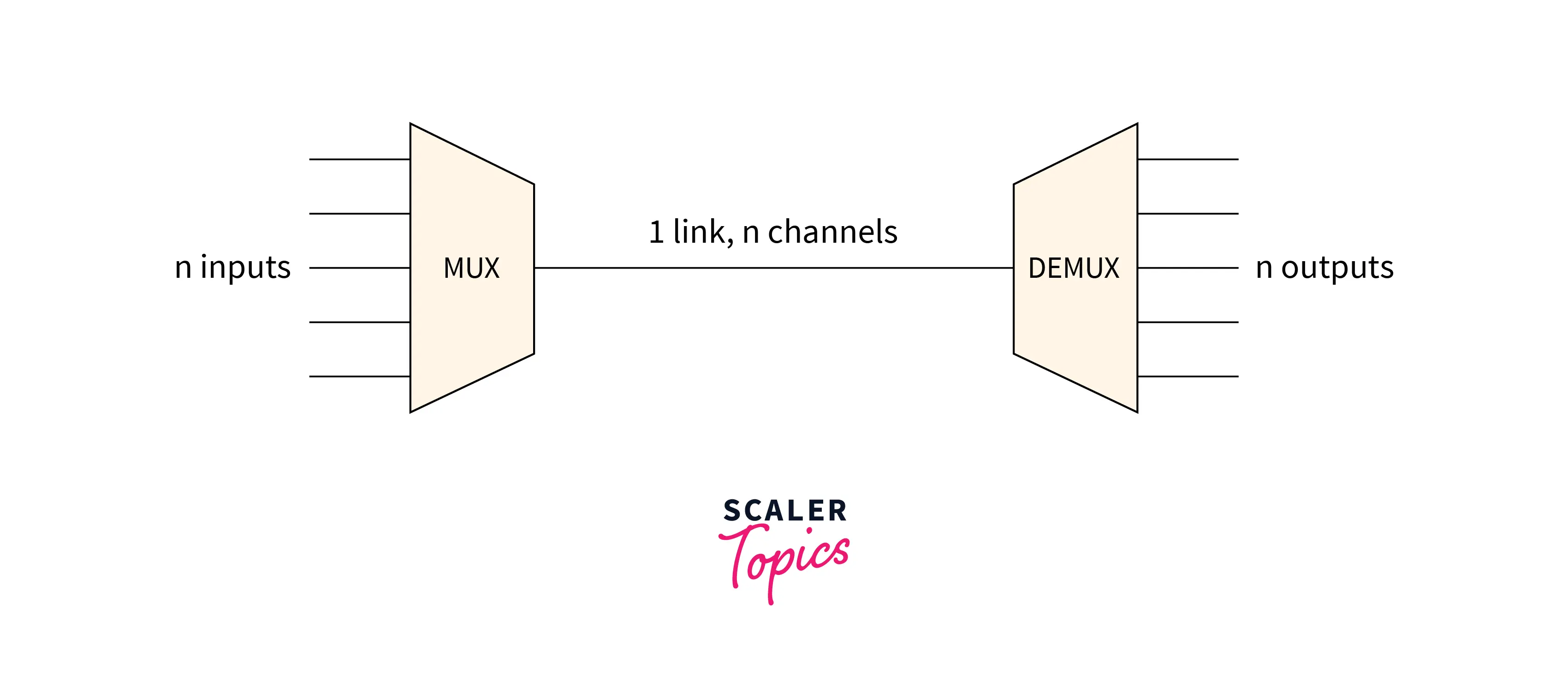
When multiple senders attempt to send over the same medium, a device known as a Multiplexer divides the physical channel and assigns one to each. On the other hand, a De-multiplexer receives data from a single medium, recognizes it, and distributes it to different recipients.
The process of combining data streams or input is called Multiplexing, and the hardware used for multiplexing is known as a Multiplexer. A Multiplexer (MUX) is a device that is used to combine n input lines to produce a single output line. Multiplexing is done in a many-to-one approach, with n input and one output line.
Demultiplexing is performed at the receiving end using a device known as a Demultiplexer (DEMUX). Demultiplexer divides a signal into its constituent signals (one input and n outputs). As a result, demultiplexing follows the one-to-many approach.
History of Multiplexing
- Early in the 1870s, telegraphy gave rise to multiplexing, which is now commonly used in communication.
- The multiplexing technique is commonly used in telecommunications to carry several phone calls over a single line.
- In 1910, George Owen Squier invented telephone carrier multiplexing.
Why Do We Need Multiplexing?
- There is a chance of collision when multiple signals share the same medium. Such collisions are avoided by using the multiplexing idea.
- When multiple signals need to be sent simultaneously from the sender side, a multiplexer is used to combine multiple signals into one so that they can be received simultaneously at the receiving end.
- Multiplexing minimizes the number of physical connections or wireless channels required to transmit numerous signals by combining them and transmitting them over a single transmission medium.
- It is costly to send multiple diverse signals separately and requires more wires, which increases the network’s overall cost. As a result, multiplexing is required. Let’s take a TV cable distributor as an example, which transmits numerous channels via a single wire.
- Bandwidth is effectively utilized. For instance, if there are ten signals and the medium’s bandwidth is 100, each signal shares ten units.
How Does Multiplexing Work?
Multiplexing combines multiple signals into one signal for transmission across a single media, such as a telephone line. The input signals can be analog or digital, depending on the sender. Multiplexing allows messages to be transferred more efficiently over a given communication channel, lowering transmission costs. The working of Multiplexing can easily be understood by the figure given below.

- On the sender end, a device Multiplexer (MUX) is used to combine n input lines to produce a single output line. Multiplexing is done in a many-to-one approach, with n input and one output line.
- On the receiver side, a device known as a
Demultiplexer (DEMUX)divides a signal into its constituent signals (one input and n outputs). As a result, demultiplexing follows the one-to-many approach.
Types of Multiplexing Techniques
There are primarily four types of Multiplexing techniques, and they are as follows:
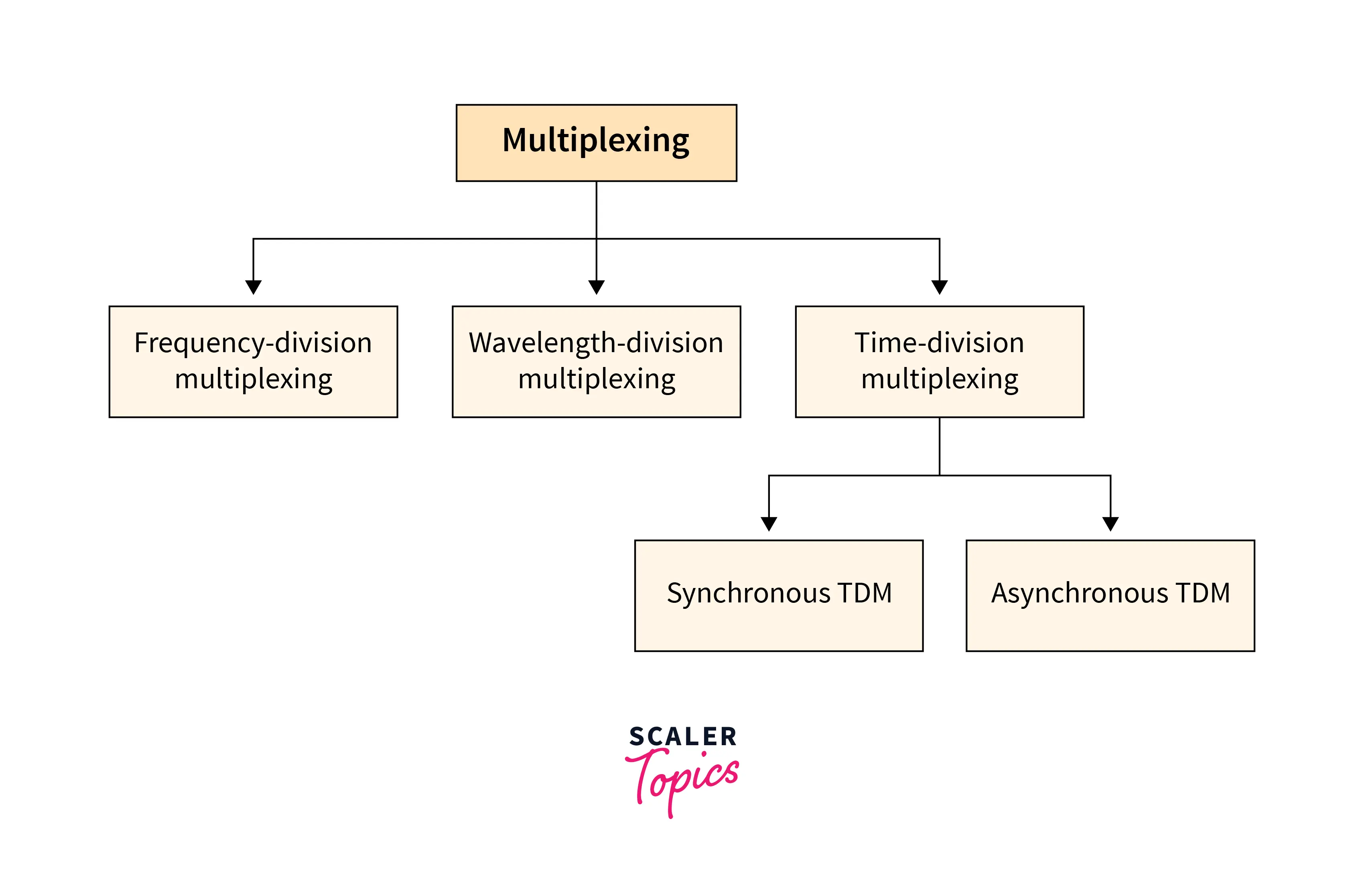
Frequency-division Multiplexing (FDM)

- Frequency division Multiplexing is a sort of multiplexing in which the bandwidth of a single physical medium is divided into several smaller, independent frequency channels.
- It is mainly used when the link’s bandwidth is greater than the combined bandwidths of the signals to be sent.
Frequency Division Multiplexing (FDM)is an analog technology.- Each signal in FDM has a different frequency.
- If the input signal for frequency division multiplexing is digital, it must be converted to analog before being sent to the modulator.
- The modulation process splits the input signals into frequency bands, which are then combined to generate a composite signal.
- We can see a lot of inter-channel cross-talk in FDM since the bandwidth is divided into frequency channels. So to prevent inter-channel cross-talk, we must place some unused bandwidth strips between every channel. These unused bandwidth strips are called guard bands. These guard bands are shown in the figure given below.
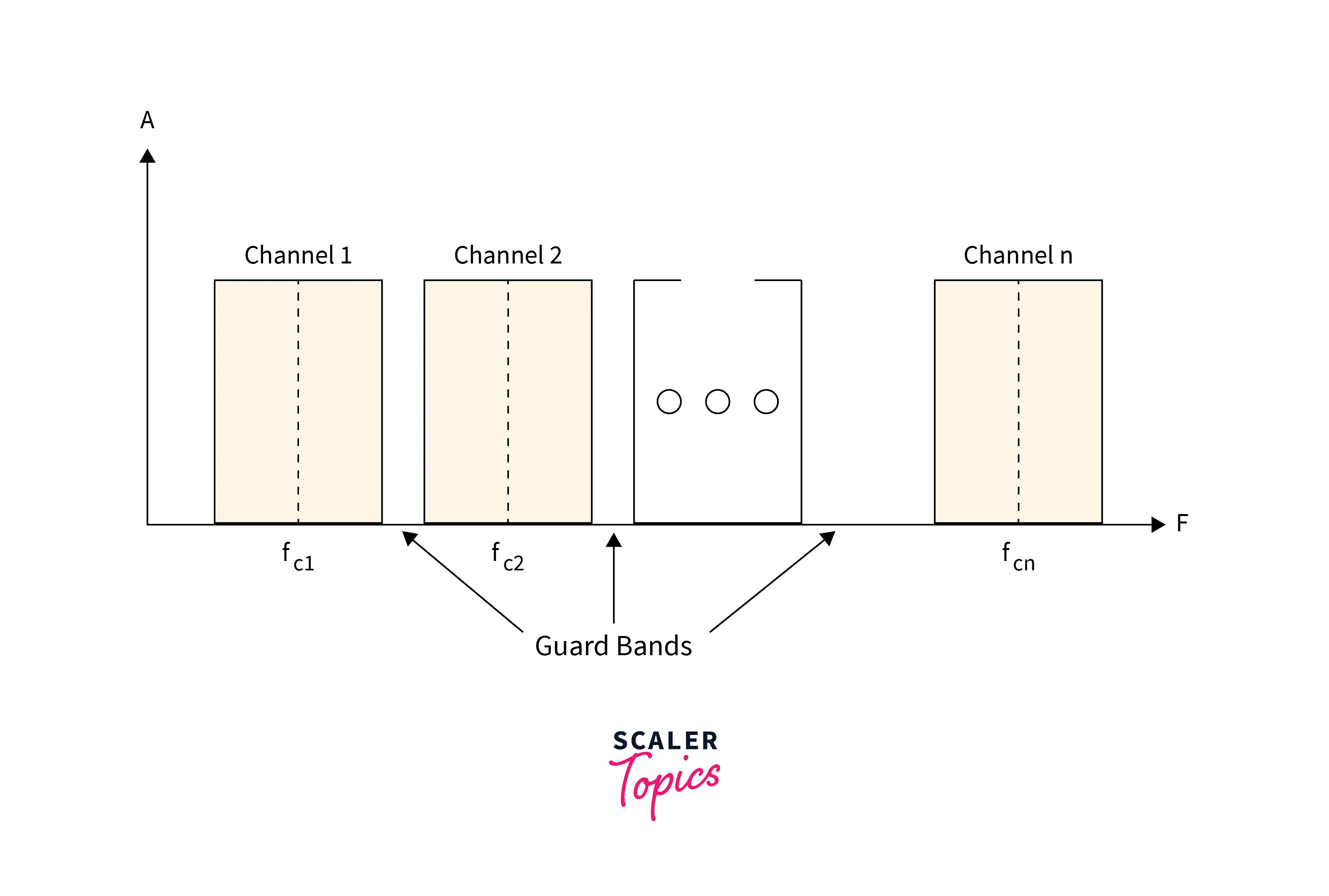
Advantages of Frequency-division Multiplexing
- The FDM modulation process is relatively simple and straightforward.
- It is simple to send a large number of signals at the same time.
- It does not require any synchronization between the transmitter and receiver.
- Slow narrowband fading affects only one channel.
- The demodulation of FDM multiplexing is simple.
Disadvantages of Frequency-division Multiplexing
- When employing FDM, the problem of cross-talk arises.
- The bandwidth of communication channels must be quite large.
- FDM is only utilized when low-speed channels are required.
- A significant number of filters and modulators are required.
- Wideband fading affects all FDM channels.
Applications of Frequency-division Multiplexing
- It is utilized in FM and AM radio broadcasts. Each FM radio station broadcasts at a different frequency, which is multiplexed to generate a composite signal. The multiplexed signal is broadcast over the air.
- FDM is also used in television broadcasting.
- FDM is utilized by first-generation cellular phones.
Wavelength Division Multiplexing (WDM)
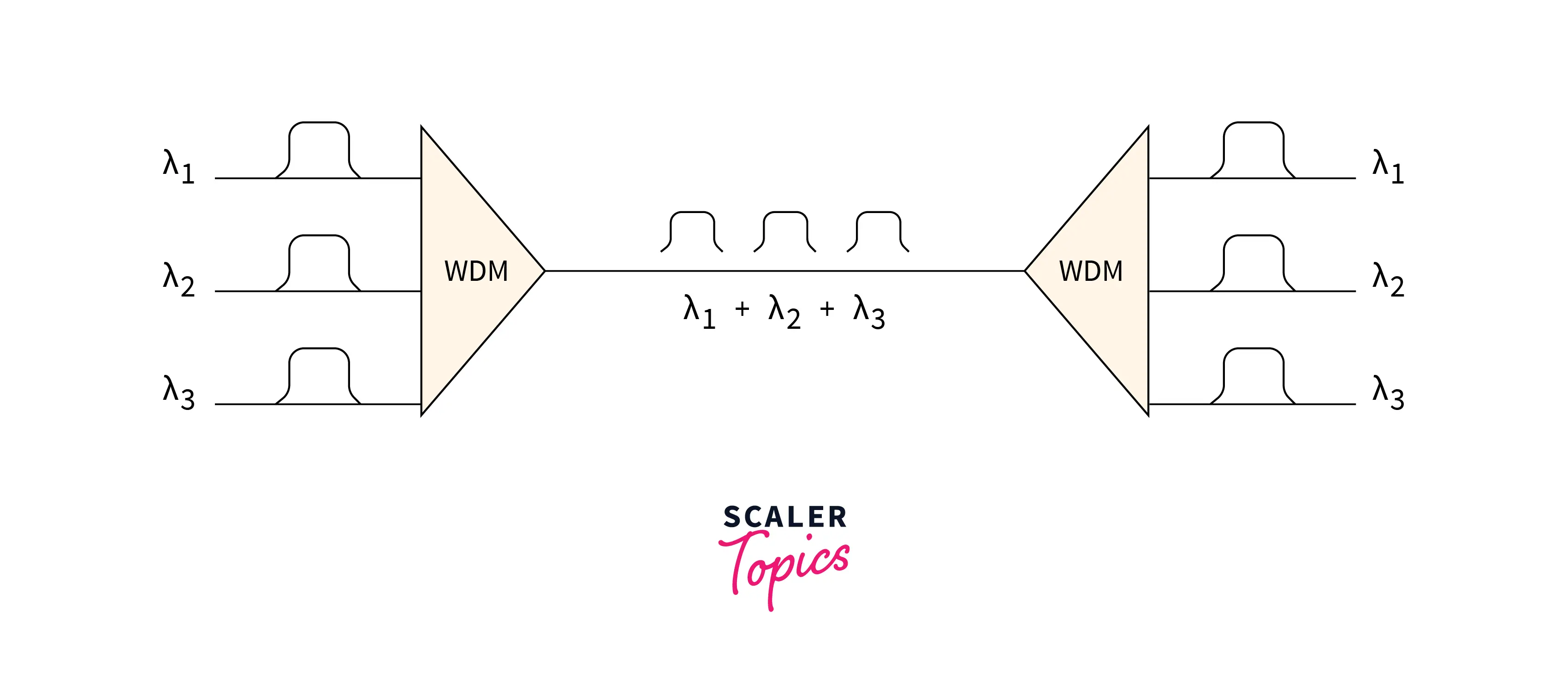
Wavelength Division Multiplexing (WDM)is used in fiber optics to increase the capacity of a single fiber.- In Wavelength Division Multiplexing, various light waves from different sources are merged into a composite light signal, and then transmitted across the channel to the receiver.
- It is an analog multiplexing approach and very much similar to FDM.
- Using multiplexers, optical signals from many sources are combined to generate a larger range of light. The demultiplexer differentiates the signals at the receiving end before sending them to their respective destinations.
- In WDM, Prisms are used to combine and split light waves. This prism assists in bending the light beam according to the angle of incidence and frequency of the light.
- Prism primarily serves as the multiplexer in the WDM technology. It then combines the multiple optical signals to create a composite signal, which is subsequently transmitted through an optical fiber connection.
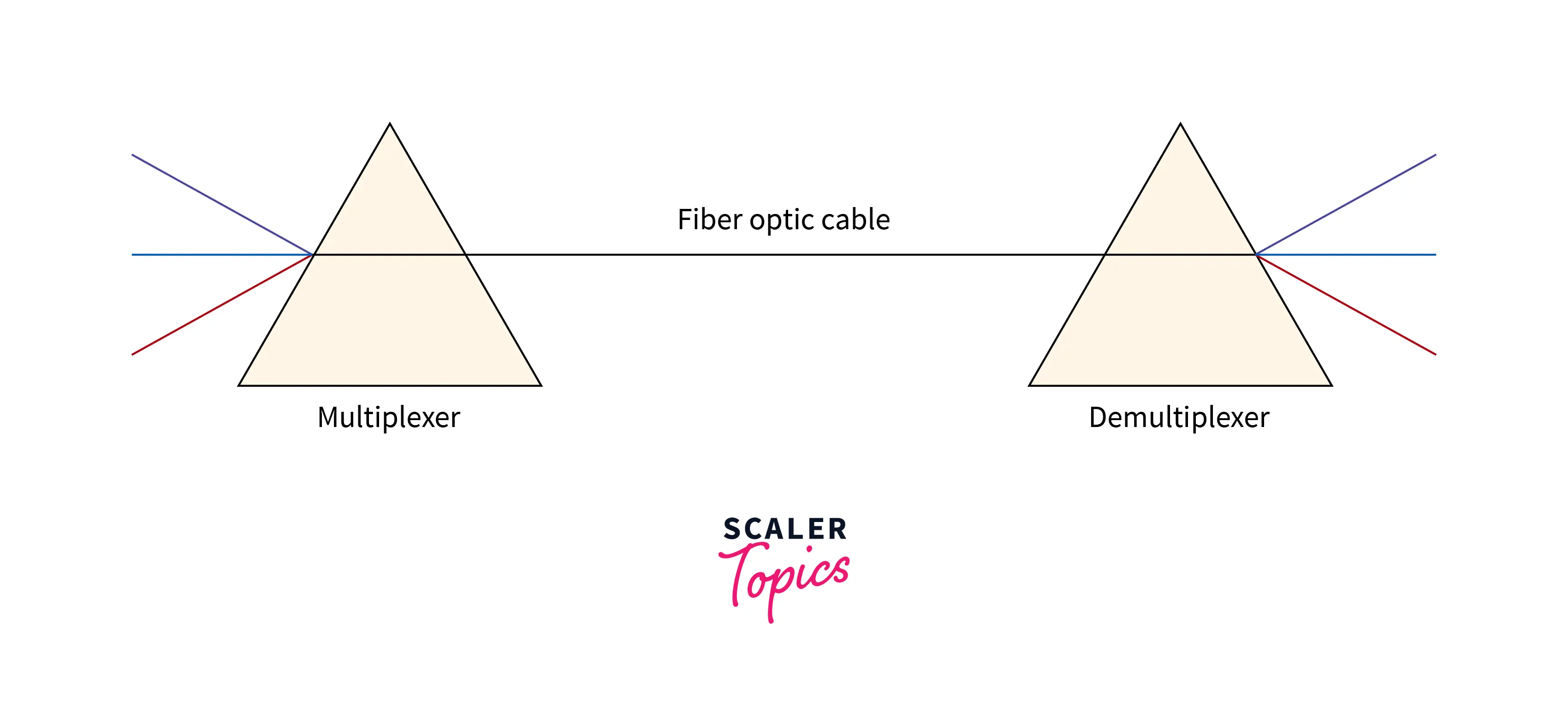
Advantages of Wavelength Division Multiplexing
- With the help of WDM, full-duplex communication is possible.
- WDM allows multiple signals to be transmitted at the same time.
- This method is less expensive, and system expansion is simple.
- This method is extremely secure.
- Since we use optical fiber in WDM, optical components are more reliable and provide higher bandwidth.
Disadvantages of Wavelength Division Multiplexing
- Inefficient bandwidth utilization might make wavelength tuning difficult.
- Transmitted signals cannot be too close to each other.
- It is less scalable.
- WDM is more expensive than FDM.
Application of Wavelength Division Multiplexing
- It is utilized in fiber optics.
- It is also used in radio frequency avionics.
Time Division Multiplexing (TDM)
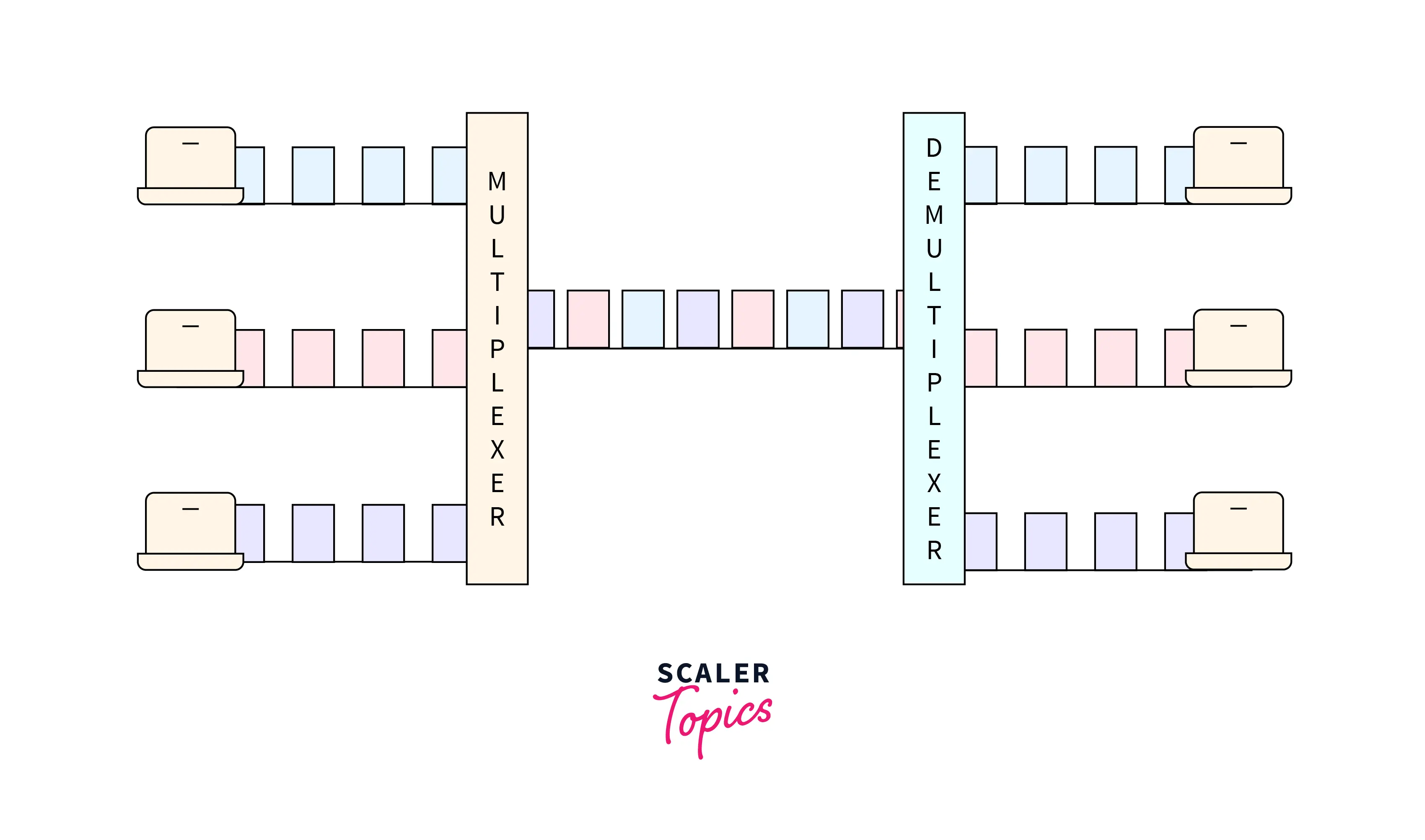
Time Division Multiplexing (TDM)divides the shared channel among its users using time slots. Each user can only send data during the time slot allotted to them.- TDM is primarily used with digital signals but can also be used with analog signals.
- Digital signals are split into frames, similar to time slots, i.e., a frame of an optimal size that can be delivered in a given time window.
- The data rate capacity in time-division multiplexing should be significantly more than the data rate required by the sending and receiving devices.
- TDM functions in the synchronized mode. Both ends, i.e., the Multiplexer and De-multiplexer, are time-synchronized and switch to the next channel simultaneously.
- For example, when channel A transmits its frame at one end, the De-multiplexer delivers media to channel A at the other end. When the time slot for channel A expires, this side switches to channel B. The De-multiplexer, on the other hand, operates in synchrony and provides media to channel B. Signals from different channels travel the path according to the time slots assigned by the TDM.
There are generally two types of Time Division Multiplexing
- Synchronous TDM
- Synchronous Time Division Multiplexing is a sort of Time Division Multiplexing in which the input frame already has a slot in the output frame. Frames are groups of time slots. A single frame is comprised of one cycle of time slots.
- Whenever its time slot arrives, each device sends data to the link. Thus, each device is given control one at a time.
- Suppose there are ‘n’ sending devices; then there will be ‘n’ time slots simultaneously, which means a one-time slot for each device.
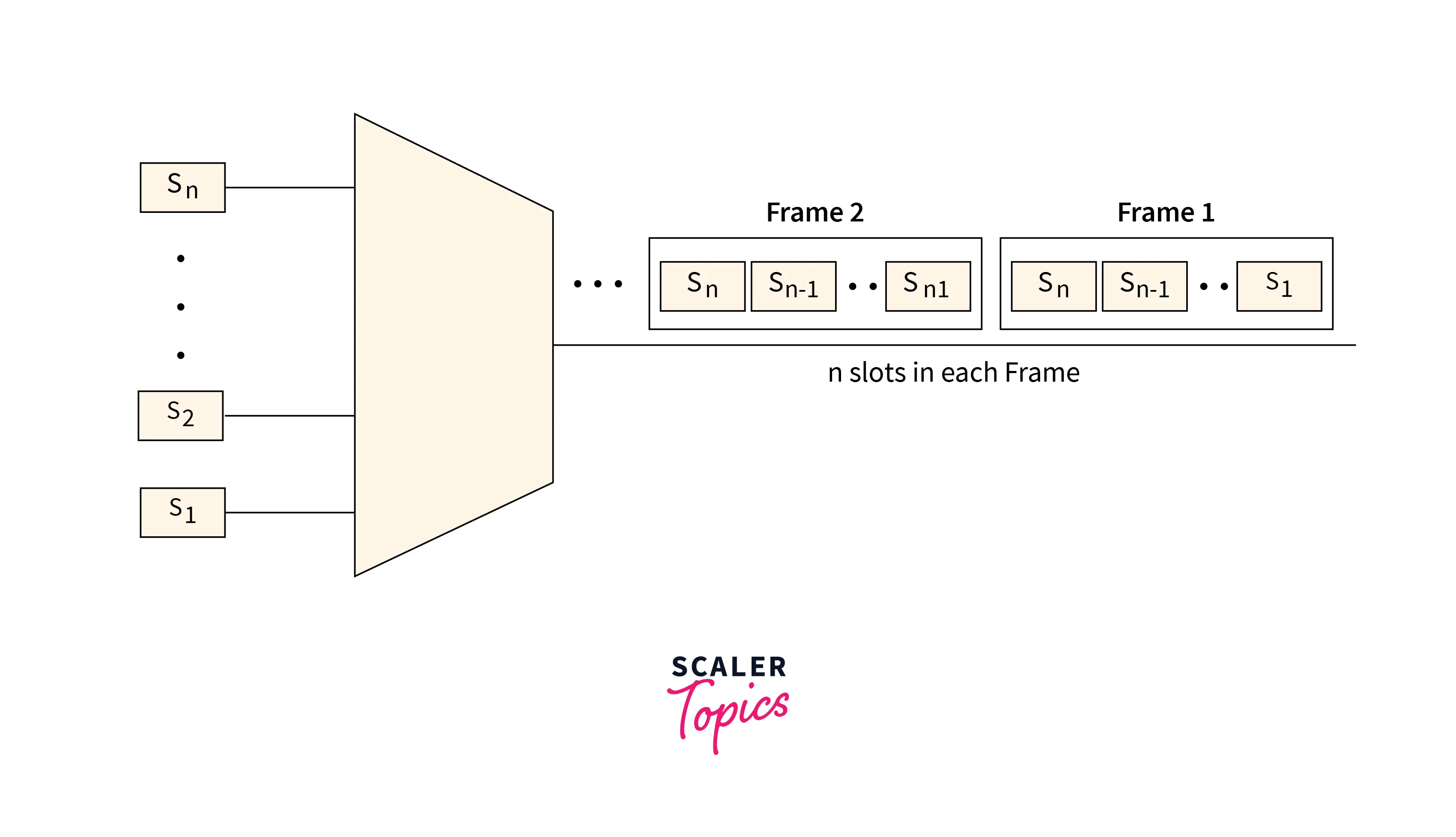
- Synchronous TDM is inefficient because if there is no data to convey in the input frame, a slot in the output frame remains vacant.
- In synchronous Time Division Multiplexing, the synchronous bit must be mentioned at the start of each frame.
- ISDN multiplexing, T-1 multiplexing, and SONET multiplexing are the most common Synchronous TDM.
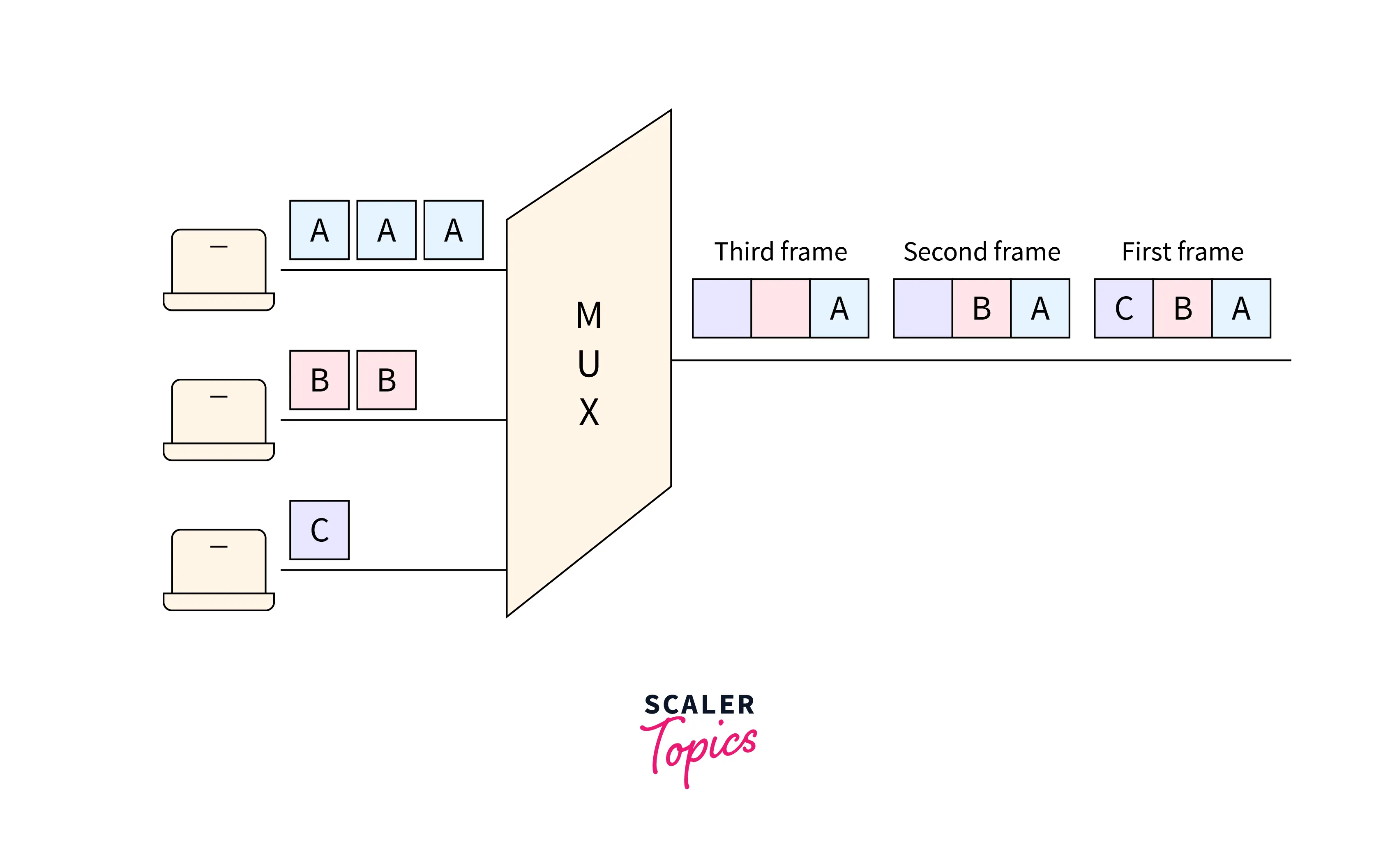 Advantages of Synchronous Time Division Multiplexing
Advantages of Synchronous Time Division Multiplexing- Synchronous Time Division Multiplexing is simple to implement.
- This strategy ensures good and reliable performance.
- The channel’s capacity is not fully utilized because empty slots with no data are also conveyed.
- The transmission medium’s speed should be greater than the overall speed of the input lines.
- Asynchronous Time Division Multiplexing
- Asynchronous Time Division Multiplexing, sometimes also known as Statical Time Division Multiplexing, is a type of multiplexing in which time slots are not set but are allocated dynamically to optimize bandwidth efficiency.
- There is no concept of predefined slots; instead, slots are assigned dynamically based on demand.
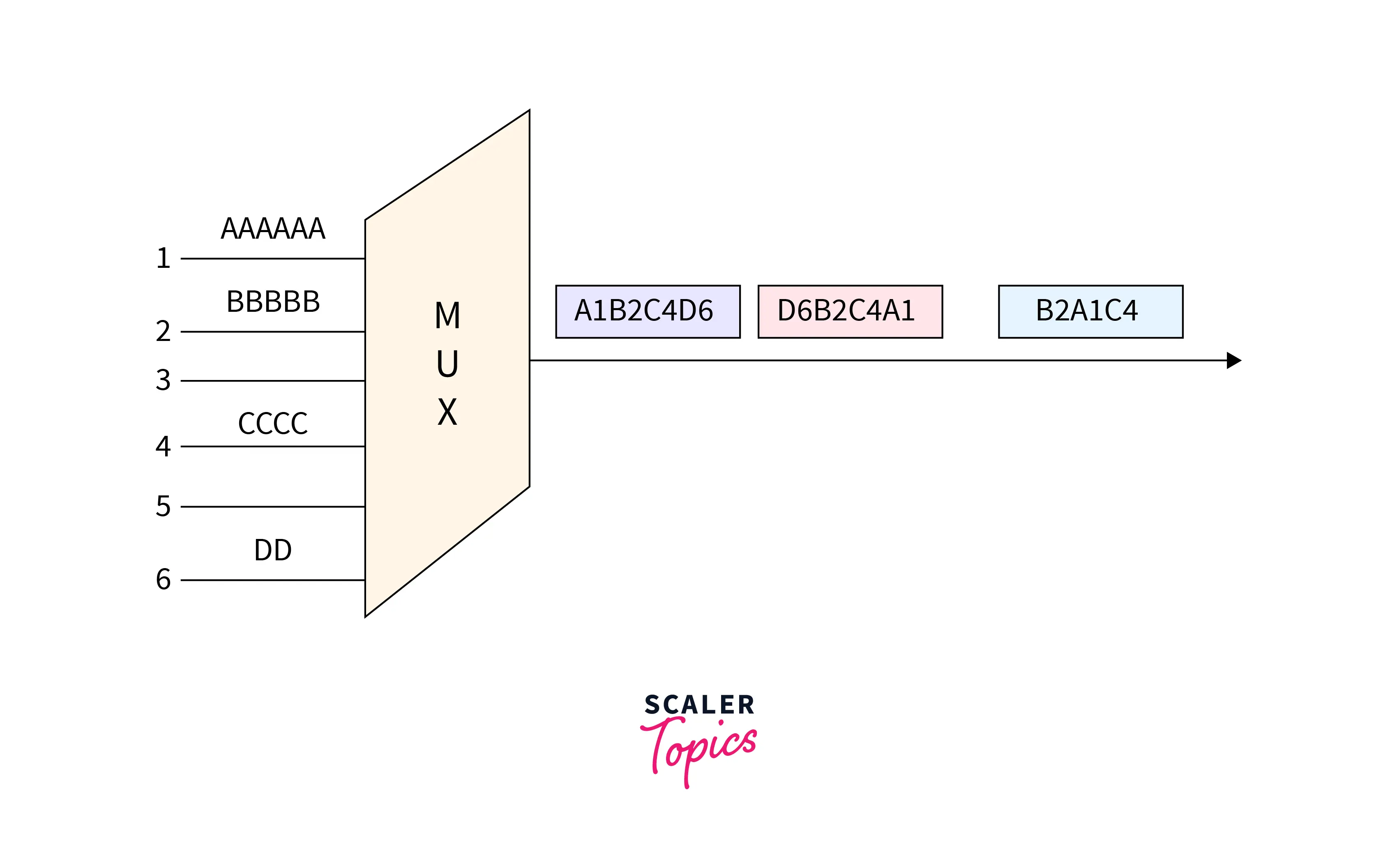
- Asynchronous Time Division multiplexer receives incoming data streams and generates a frame with no empty slots.
- There are n input lines and m slots in this Multiplexing; therefore, always (m<n).
- The overall speed of the input lines in asynchronous TDM can be more than the channel capacity.
- The distinction between Asynchronous TDM and Synchronous TDM is that many slots in Synchronous TDM are unused, whereas slots in Asynchronous TDM are entirely utilized. This results in a shorter transmission time and more efficient channel utilization.
- Each slot in Asynchronous TDM comprises an address element that identifies the data source.
 Advantages of Asynchronous Time Division Multiplexing
Advantages of Asynchronous Time Division Multiplexing- The transmission capacity is used efficiently in this multiplexing.
- Since there are no dedicated slots for each user, the buffer address information is also required.
- The waiting time is not fixed.
Code Division Multiplexing (CDM)
- We can send Multiple data signals over a single frequency via code division multiplexing.
- FDM divides the frequency into smaller channels, but CDM allows users to use the entire bandwidth and transmit signals simultaneously using a unique code. CDM spreads signals using orthogonal codes.
- Each station is given a unique code, known as a chip. Signals flow independently with these codes throughout the entire bandwidth. The chip code signal that the receiver must receive is known in advance.
- Code Division Multiplexing is widely used in digital television and radio broadcasting, as well as in 3G mobile cellular networks, while 4G and 5G predominantly employ
OFDM(Orthogonal Frequency Division Multiplexing).
Some Other Types of Multiplexing
Orthogonal Frequency Division Multiplexing (OFDM)
Orthogonal frequency-division multiplexing is a data transmission method in which a single information stream is distributed over several closely spaced narrowband subchannel frequencies rather than a single Wideband channel frequency. It is typically used in wireless data transfer, but it can also be used in cable and fiber optic communication.
Each data bit is supplied serially or sequentially, one after the other, in a traditional single-channel modulation technique. Several bits can be transmitted in parallel or simultaneously in independent substream channels in OFDM. This allows each substream’s data rate to be lower than that of a single stream of similar bandwidth. This reduces the system’s susceptibility to interference and allows for more efficient data bandwidth. The figure below compares the OFDM with traditional single-channel wireless transmission and standard Frequency Division Multiplexing (FDM).
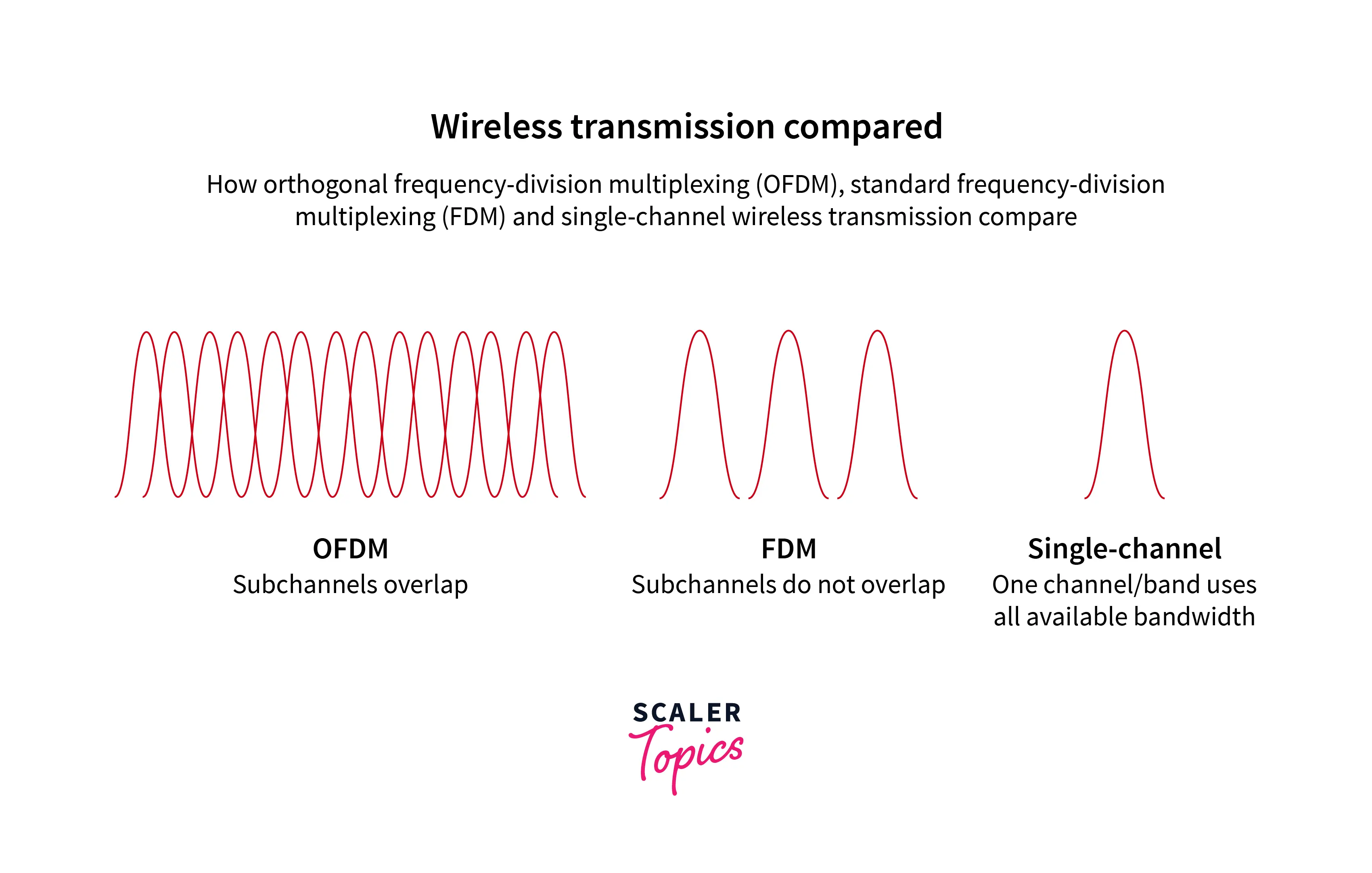
Space Division Multiplexing (SDM)
Multiple conductors, such as optical fibers or electrical lines, are used to divide signal routes physically. The conductors are packed into a single transport medium but physically separated, with each conductor handling a transmission channel. Individual conductors can be multiplexed further using FDM, TDM, or other techniques. SDM is frequently employed to enhance capacity in underwater cable networks but can also be utilized for wireless communications.
Elevate your understanding of computer networks with Scaler Topics free course. Enroll today and pave the way for a rewarding career in IT.
Conclusion
- Multiplexing is a technique that allows different analog and digital transmission streams to be handled at the same time across a shared link.
- The process of combining data streams or input is called Multiplexing, and the hardware used for multiplexing is known as a Multiplexer.
- A
Multiplexer (MUX)is a device that is used to combine n input lines to produce a single output line. - Demultiplexing is performed at the receiving end using a device known as a
Demultiplexer (DEMUX). Demultiplexer divides a signal into its constituent signals (one input and n outputs). - There are primarily four types of Multiplexing techniques, and they are
Frequency-division Multiplexing (FDM),Wavelength Division Multiplexing (WDM),Time Division Multiplexing (TDM), andCode Division Multiplexing (CDM). - Frequency division Multiplexing is a sort of multiplexing in which the bandwidth of a single physical medium is divided into several smaller, independent frequency channels.
- In Wavelength Division Multiplexing, various light waves from different sources are merged into a composite light signal, then transmitted across the channel to the receiver.
Time Division Multiplexing (TDM)divides the shared channel among its users using time slots. Each user can only send data during the time slot allotted to them.Code Division Multiplexing (CDM)allows users to use the entire bandwidth and transmit signals simultaneously using a unique code. CDM spreads signals using orthogonal codes.
